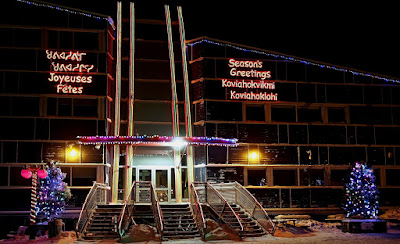Following the previous post on the
Torngat Range mountains, this is now about two small inuit villages on
Ungava Bay, by the Hudson Strait entrance to
Hudson Bay.
Kangiqsualujjuaq and
Kuujjuaq, 100 km to the west of the Torngats, are old settlements but they grew more important with the reallocation of inuit scattered communities by the government around the 60´s-70´s. Both are also situated close to the tree-line separating forest from tundra, so mixed terrains and flora border the local rivers.
Kangiqsualujjuaq is an Inuit village located on the east coast of
Ungava Bay at the mouth of the
George River, in Nunavik, Canada.
The name "
Kangiqsualujjuaq" means "
very large bay" in Inuit language.
Coordinates: 58°41′ N, 65° 57′ W
(sub-arctic)
Population: ~ 900.
The town itself is laid out on a grid pattern over levelled ground, with two unsealed roads leading a few kilometres beyond the mountain ridges at either end of the village.
Kangiqsualujjuaq did not really develop as a village before the early 1960s. The
Hudson Bay Company operated a post south of today's village, called
George River. Since 1959, the Inuit populations living around established there the first co-operative in Northern Quebec for the purpose of marketing Arctic char, and the population started growing.
The construction of the village began in 1962 and, a few years later, all inhabitants of
George River lived in prefabricated houses. A school was built in 1963, as well as a Coop store, post office and other facilities. In 1980,
Kangiqsualujjuaq was definitely a town.
The community was stricken by an avalanche in the early morning of January 1, 1999, during the New Year celebrations. The school Gymnasium was destroyed, with fatalities. A new school was built in a safer distance from the dangerous hillside -
Ulluriaq school.
Ulluriaq school.
Biking is whenever possible.
School bus.
The heated indoor pool, built in 2007, a precious new facilty. There is also a covered Arena for ice hockey, and a Youth Center for music, Voleyball, pool and other activities.
The new senior residence. Canada makes en effort to improve the quality of life of the northern native population that you don't see in Alaska or Siberia.
The local Hostel.
New two-story houses have improved comfort.
-
45º is 'normal' in Winter; houses are built on piles (or stilts) to help insulation and stiffness.
Twilight in Kangiqsualujjuaq.
The main activities in Kangiqsualujjuaq include hunting of caribou, seal and beluga whale, Arctic char and salmon fishing. Inuit crafts provide presently an additional income.
Life here is closely linked to the river and the rythm of its tides, as tidal movements from the river's mouth run upstream to the village.
George River
George River is famous for caribou herds living nearby and offering the sight of caribou crossing the waters.
Though suffering a dramatic decline some years ago, the George River caribou herd rebounded with amazing vitality, and is presently the largest ungulate population in the world, estimated at several hundreds of thousands of heads.
In a single year, some of these animals will travel thousands of kilometers across Canada’s boreal forest between their wintering and calving grounds.
The George River also teems with fish, particularly arctic char, Atlantic salmon and a variety of trout. Many visitors are attracted by its offer of unbelievable fishing.
Glorious light under spring sun on quiet waters.
---------------------
NEXT: Kuujjuaq, the main town in Nunavik.
































































